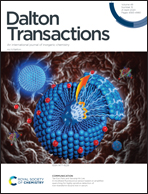Iridium(iii) complexes with the dithieno[3,2-b:2′,3′-d]phosphole oxide group and their high optical power limiting performances†
Abstract
A new 2-phenylpyridine-type (ppy-type) ligand with the dithieno[3,2-b:2′,3′-d]phosphole oxide (DTPO) group has been successfully synthesized. Based on this novel ligand, three cyclometalated iridium(III) complexes (P–Ir–P, P–Ir–T and P–Ir–C) are synthesized with symmetrical and unsymmetrical structures. Photophysical results reveal that these cyclometalated iridium(III) complexes can show weak near-infrared (NIR) phosphorescence emission with wavelengths of 739 nm for P–Ir–P, 750 nm for P–Ir–T and 746 nm for P–Ir–C. Importantly, transient absorption characterization shows that these cyclometalated iridium(III) complexes can exhibit strong excited state absorption in the range of ca. 520 to 700 nm, indicating their optical power limiting (OPL) potential in this wavelength range. Open-aperture Z-scan against a 532 nm laser shows their OPL ability in the order of P–Ir–P > P–Ir–C > P–Ir–T. Complex P–Ir–P shows an even better OPL ability than the state-of-the-art OPL material C60, indicating the important potential application of these cyclometalated iridium(III) complexes as new OPL materials.
![Graphical abstract: Iridium(iii) complexes with the dithieno[3,2-b:2′,3′-d]phosphole oxide group and their high optical power limiting performances](/en/Image/Get?imageInfo.ImageType=GA&imageInfo.ImageIdentifier.ManuscriptID=D0DT00102C&imageInfo.ImageIdentifier.Year=2020)


 Please wait while we load your content...
Please wait while we load your content...